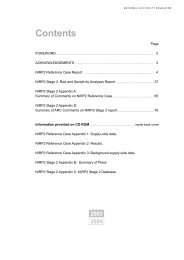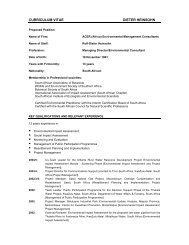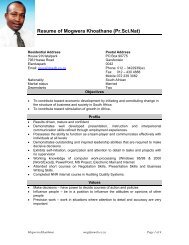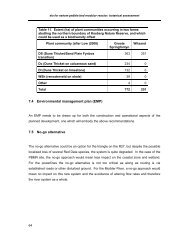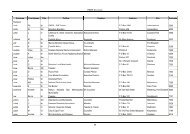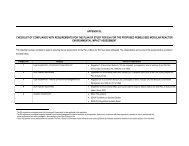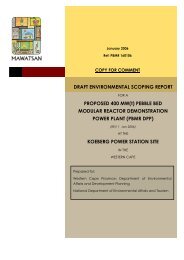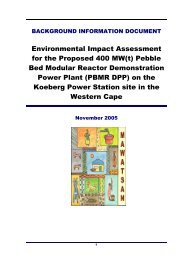Chapter 6 : Legal Framework - PBMR
Chapter 6 : Legal Framework - PBMR
Chapter 6 : Legal Framework - PBMR
You also want an ePaper? Increase the reach of your titles
YUMPU automatically turns print PDFs into web optimized ePapers that Google loves.
CHAPTER 6: LEGAL FRAMEWORK<br />
6.1 INTERDEPARTMENTAL COLLABORATION<br />
At the outset of the EIA, the Department of Environmental Affairs and Tourism (DEAT) as<br />
the lead authority on environmental matters, and the National Nuclear Regulator (NNR)<br />
agreed to work in close collaboration regarding the assessment of nuclear related matters<br />
associated with the project. As a result, the scoping report reflects numerous issues<br />
relating to nuclear safety that were raised by interested and affected parties (I&APs).<br />
Such issues will be dealt with in terms of the National Nuclear Regulator Act (Act No. 47 of<br />
1999). The National Nuclear Regulator (NNR) nuclear installation licence process is<br />
detailed below.<br />
The National Nuclear Regulator Act (Act No. 47 of 1999) authorises the NNR to:<br />
Provide for the protection of persons, property and the environment against nuclear<br />
damage through the establishment of safety and regulatory practices.<br />
These safety standard and regulatory practices typically include risk criteria addressing risk<br />
to public and workers, radiation dose limits due to normal operation, fundamental safety<br />
principles including as-low-as-reasonably-achievable (ALARA) and defence-in-depth,<br />
general safety principles related to international standards and requirements for<br />
emergency planning.<br />
Subject to the NNR board’s approval, the Chief Executive Officer (CEO) may:<br />
refuse an application for a nuclear installation licence and must provide the applicant<br />
with the reasons for the refusal in writing; or<br />
grant an application for a nuclear installation licence, subject to such conditions.<br />
In order to give practical impetus to the process described above a cooperative<br />
governance agreement was entered into between the DEAT and the NNR. The process<br />
described in this agreement will be followed to address radiological and nuclear safety<br />
related issues during this EIA.<br />
6.2 STATUTORY FRAMEWORK<br />
Beside the normal decision-making structures for an EIA, several other acts, regulations<br />
and treaties apply to this particular proposed study. These include, inter alia:<br />
6.2.1 ACTS<br />
The Constitution of South Africa (Act 108 of 1996);<br />
National Environmental Management Act (Act 107 of 1998);<br />
National Heritage Resources Act (Act 25 of 1999);
National Roads Traffic Act (Act 93 of 1996);<br />
National Water Act (Act 36 of 1998);<br />
Occupational Health and Safety Act (Act 85 of 1993);<br />
Physical Planning Act (Act 125 of 1991);<br />
Promotion of Access to Information Act (Act 2 of 2000);<br />
The Atmospheric Pollution Prevention Act (Act 45 of 1965);<br />
The Electricity Act (Act 41 of 1987);<br />
The Environmental Conservation Act (Act 73 of 1989);<br />
The Hazardous Substances Act (Act 15 of 1973);<br />
The National Nuclear Regulator Act (Act 47 of 1999);<br />
The Nuclear Act (Act 46 of 1999);<br />
The Seashore Act (Act 21 of 1935);<br />
Dumping at Sea Control Act, 1980;<br />
Air Quality Act, 2004 (in force 11/09/05);<br />
Compensation for Occupational Injuries and Diseases Act (Act 130 of 1993);<br />
Disaster Management Act (Act 57 of 2002);<br />
National Building Regulations and Building Standards Act (Act 103 of 1977);<br />
National Key Points Act (Act 102 of 1980).<br />
6.2.2 PROVINCIAL/LOCAL LEGISLATION<br />
Land Use Planning Ordinance (Ordinance 15 of 1985);<br />
Local By-laws.<br />
6.2.3 REGULATIONS<br />
The EIA Regulations, Regulation R1182, 1183 and 1184 as published in the Government<br />
Gazette of 5 September 1997.<br />
6.2.4 TREATIES<br />
National Nuclear Non-Proliferation Treaty enacted by the Nuclear Energy Act.<br />
The Basel Convention on Transboundary Waste Transport.<br />
6.3 NUCLEAR LICENCE PROCESS<br />
In addition to the EIA process, the project proponent also needs nuclear installation<br />
licences for the proposed nuclear activities.
These licences must be obtained from the National Nuclear Regulator (NNR) and are<br />
required under the National Nuclear Regulator Act (Act 47 of 1999). The act states that no<br />
person may site, construct, operate, decontaminate or decommission a nuclear<br />
installation, except under the authority of a nuclear installation licence. Section 21 of the<br />
Act makes provision for persons wishing to engage in any of these activities to apply to the<br />
(CEO) of the NNR for such a licence. It is important to note that different requirements<br />
exist for the nuclear installation licence and the EIA process.<br />
As is the case with the EIA process, the licence process is a sequential (staged) process.<br />
Unlike the EIA process, the licence process is ongoing (i.e. throughout the life cycle of the<br />
project – planning, construction, commissioning, operation / maintenance and<br />
decommissioning).<br />
The involvement of the public in the licence process is at the discretion of the CEO of the<br />
NNR. In terms of the Act, the CEO of the NNR is obliged to direct the applicant for a<br />
nuclear installation licence to serve a copy of the application upon:<br />
every municipality affected by the application;<br />
such other body or person as the CEO determines;<br />
publish a copy of the application in the Government Gazette and two newspapers<br />
circulating in the area of every such municipality.<br />
Any person(s) who may be directly affected by the granting of a nuclear installation<br />
licence pursuant to an application, may make representation to the NNR Board on<br />
matters relating to radiological health, safety and environmental issues connected to the<br />
application, within 30 days of the date of publication in the Government Gazette.<br />
For nuclear installations and the transport of nuclear material(s), the licence process<br />
entails the setting down of standards expressed in terms of:<br />
the quality of engineering and operation required;<br />
the limitation of radiation exposure to people.<br />
The prime considerations during a good nuclear safety design are the principles of<br />
“ALARA” (As low as reasonable achievable) and “defence-in depth”.<br />
With regard to good nuclear safety design practice, of prime consideration are the<br />
principles of defence-in-depth and of ensuring that risks and radiation doses to members<br />
of the public and workers will be maintained as low as reasonably achievable (ALARA)<br />
below the stipulated radiation dose limits.<br />
The principle of “defence-in-depth” requires that there should be multiple layers<br />
(structures, components, systems, procedures or a combination thereof) with overlapping<br />
safety provisions. Accident prevention and accident mitigation are natural<br />
consequences of the defence-in-depth principle.<br />
Besides the normal decision-making structures for an EIA, several other approvals apply to<br />
this particular proposed study. These steps in the approval process include:
DEAT must approve the EIA in co-operative agreement with the relevant provincial<br />
environmental authorities.<br />
The NNR must approve the nuclear safety aspects of the design, construction and<br />
operation/maintenance of the plant(s) (electricity generation and fuel manufacture)<br />
as well as the transportation of nuclear materials.<br />
Thereafter, Cabinet must consider all of the information in the documents that result<br />
from the above studies, and approve the construction of a demonstration module<br />
<strong>PBMR</strong> to demonstrate the techno-economic feasibility of the technology.<br />
After cabinet approval of this project, various permits must be applied for and issued<br />
for land-use, emission releases, effluent disposal, conventional waste disposal and<br />
water use.<br />
6.4 ESKOM’S INTEGRATED STRATEGIC ELECTRICITY PROGRAMME<br />
(ISEP)<br />
Eskom also has responsibilities in respect of the White Paper on National Energy Policy.<br />
Eskom uses a programme called the Integrated Strategic Electricity Programme (ISEP) to<br />
guide their planning process.<br />
As stated previously, the ISEP concerns supply-side and demand-side options. The <strong>PBMR</strong> is<br />
an option for the supply-side.<br />
ISEP is the way in which Eskom assesses by how much the demand for electricity is likely to<br />
grow, and how best to meet and manage that demand. Long-term economic forecasts<br />
are made and provide the framework to investigate and implement a wide range of new<br />
supply-side and demand-side technologies.<br />
As part of the ongoing effort to evaluate the viability of all the supply-side options, a<br />
number of power generation technologies, which have not yet been implemented in<br />
South Africa on a commercial basis, are being evaluated in terms of technical, socioeconomic<br />
and environmental aspects.<br />
6.5 AUTHORISATIONS AND PERMITS TO BE OBTAINED<br />
Table 1 summarises the permits that may be required for the proposed project, their legal<br />
basis and the authorities that would be required to issue them.<br />
Table 1: Permits potentially required for the proposed project<br />
LEGAL BASIS DEPARTMENT NATURE OF PERMIT<br />
Environment Conservation Act,<br />
73/1989 (sect 21,22,26 and Sept<br />
1997 regulations)<br />
Dept of Environmental Affairs<br />
and Tourism<br />
Environmental Impact<br />
Authorisation<br />
National Environmental<br />
Management Act, 107 of 1998<br />
Dept of Environmental Affairs<br />
Environmental Impact<br />
Authorisation: New EIA
LEGAL BASIS DEPARTMENT NATURE OF PERMIT<br />
(sect 24) and Tourism regulations<br />
National Water Act, 36 of 1998<br />
Atmospheric Pollution<br />
Prevention Act 45 of 1965<br />
National Environmental<br />
Management: Air Quality Act,<br />
39 of 2004<br />
Dept. of Water Affairs and<br />
Forestry (DWAF), regional office<br />
Cape Town<br />
Dept of Environmental Affairs<br />
and Tourism<br />
Dept of Environmental Affairs<br />
and Tourism<br />
Permission to carry out “water<br />
use” – widely defined<br />
Noxious & Offensive gas permit:<br />
Scheduled process under<br />
Annexure APPA<br />
Act promulgated regulations<br />
not formulated<br />
Nuclear Regulator Act 47/1999<br />
(Sect 20(1))<br />
Nuclear Energy Act 46/1999<br />
(Sect 46)<br />
Nuclear Energy Act 46/1999<br />
(Sect 34)<br />
Land Use Planning Ordinance<br />
15/1985<br />
National Nuclear Regulator<br />
Department of Minerals and<br />
Energy<br />
Department of Minerals and<br />
Energy<br />
Western Cape Provincial Dept of<br />
Environment & Development<br />
Planning<br />
Nuclear installation licence:<br />
Authorisation for sitting,<br />
constructing, operating,<br />
decontaminating or<br />
decommissioning a nuclear<br />
installation<br />
Dealing with nuclear waste –<br />
permit requirement<br />
Identified Authorizations by the<br />
Minister<br />
Rezoning i.t.o. 14.4(a)<br />
Full Rezoning process<br />
In addition to the legislation mentioned in Table 1, the Department of Minerals and Energy<br />
has established a national policy on the management of radioactive waste, including<br />
spent fuel.



